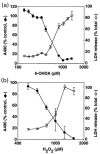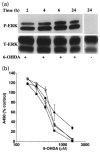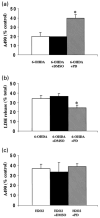Sustained extracellular signal-regulated kinase activation by 6-hydroxydopamine: implications for Parkinson's disease
- PMID: 11359871
- PMCID: PMC1868550
- DOI: 10.1046/j.1471-4159.2001.00304.x
Sustained extracellular signal-regulated kinase activation by 6-hydroxydopamine: implications for Parkinson's disease
Abstract
Although the toxin 6-hydroxydopamine (6-OHDA) is utilized extensively in animal models of Parkinson's disease, the underlying mechanism of its toxic effects on dopaminergic neurons is not completely understood. We examined the effects of 6-OHDA on the CNS-derived tyrosine hydroxylase expressing B65 cell line, with particular attention to the regulation of the extracellular signal-regulated protein kinases (ERK). 6-OHDA elicited a dose-dependent cytotoxicity in B65 cells. Toxic doses of 6-OHDA also elicited a biphasic pattern of ERK phosphorylation with a prominent sustained phase, a pattern that differed from that observed with hydrogen peroxide (H(2)O(2)) treatment. 6-OHDA-elicited ERK phosphorylation was blocked by PD98059, an inhibitor of the upstream mitogen activated protein kinase kinase (MEK) that phosphorylates and activates ERK. PD98059 also conferred protection against 6-OHDA cytotoxicity, but did not affect H(2)O(2) toxicity in B65 cells. These results suggest that ERK activation plays a direct mechanistic role in 6-OHDA toxicity, rather than representing a protective compensatory response, and raise the possibility that abnormal patterns of ERK activation may contribute to dopaminergic neuronal cell death.
Figures






Similar articles
-
Role of reactive oxygen species in extracellular signal-regulated protein kinase phosphorylation and 6-hydroxydopamine cytotoxicity.J Biosci. 2003 Feb;28(1):83-9. doi: 10.1007/BF02970136. J Biosci. 2003. PMID: 12682429 Free PMC article.
-
Protein kinase C delta mediated cytotoxicity of 6-Hydroxydopamine via sustained extracellular signal-regulated kinase 1/2 activation in PC12 cells.Neurol Res. 2014 Jan;36(1):53-64. doi: 10.1179/1743132813Y.0000000267. Epub 2013 Dec 6. Neurol Res. 2014. PMID: 24107416
-
The roles of cyclic AMP-ERK-Bad signaling pathways on 6-hydroxydopamine-induced cell survival and death in PC12 cells.Toxicol In Vitro. 2013 Dec;27(8):2233-41. doi: 10.1016/j.tiv.2013.09.014. Epub 2013 Sep 20. Toxicol In Vitro. 2013. PMID: 24055892
-
Mechanism of 6-hydroxydopamine neurotoxicity.J Neural Transm Suppl. 1997;50:55-66. doi: 10.1007/978-3-7091-6842-4_7. J Neural Transm Suppl. 1997. PMID: 9120425 Review.
-
6-Hydroxydopamine: a far from simple neurotoxin.J Neural Transm (Vienna). 2020 Feb;127(2):213-230. doi: 10.1007/s00702-019-02133-6. Epub 2020 Jan 1. J Neural Transm (Vienna). 2020. PMID: 31894418 Review.
Cited by
-
Stress-induced nuclear translocation of CDK5 suppresses neuronal death by downregulating ERK activation via VRK3 phosphorylation.Sci Rep. 2016 Jun 27;6:28634. doi: 10.1038/srep28634. Sci Rep. 2016. PMID: 27346674 Free PMC article.
-
Ethyl pyruvate protects SHSY5Y cells against 6-hydroxydopamine-induced neurotoxicity by upregulating autophagy.PLoS One. 2023 Feb 16;18(2):e0281957. doi: 10.1371/journal.pone.0281957. eCollection 2023. PLoS One. 2023. PMID: 36795720 Free PMC article.
-
Role of reactive oxygen species in extracellular signal-regulated protein kinase phosphorylation and 6-hydroxydopamine cytotoxicity.J Biosci. 2003 Feb;28(1):83-9. doi: 10.1007/BF02970136. J Biosci. 2003. PMID: 12682429 Free PMC article.
-
Mitochondrial dysfunction and oxidative stress in Parkinson's disease.Neurochem Res. 2008 Mar;33(3):589-97. doi: 10.1007/s11064-007-9482-y. Epub 2007 Oct 17. Neurochem Res. 2008. PMID: 17940895 Review.
-
Quantitative proteomic analysis reveals the effects of mu opioid agonists on HT22 cells.Front Pharmacol. 2023 Jan 9;13:1022449. doi: 10.3389/fphar.2022.1022449. eCollection 2022. Front Pharmacol. 2023. PMID: 36699066 Free PMC article.
References
-
- Alessi DR, Cuenda A, Cohen P, Dudley DT, Saltiel AR. PD 098059 is a specific inhibitor of the activation of mitogen-activated protein kinase kinase in vitro and in vivo. J Biol Chem. 1995;270:27489–27494. - PubMed
-
- Ambani LM, Van Woert MH, Murphy S. Brain peroxidase and catalase in Parkinson disease. Arch Neurol. 1975;32:114–118. - PubMed
-
- Andrew R, Watson DG, Best SA, Midgley JM, Wenlong H, Petty RKH. The determination of hydroxydopamines and other trace amines in the urine of Parkinsonian patients and normal controls. Neurochem Res. 1993;18:1175–1177. - PubMed
-
- Asanuma M, Hirata H, Cadet JL. Attenuation of 6-hydroxydopamine-induced dopaminergic nigrostriatal lesions in superoxide dismutase transgenic mice. Neuroscience. 1998;85:907–917. - PubMed
-
- Beal MF. Aging, energy, and oxidative stress in neurodegenerative diseases. Ann Neurol. 1995;38:357–366. - PubMed
Publication types
MeSH terms
Substances
Grants and funding
LinkOut - more resources
Full Text Sources
Other Literature Sources
Miscellaneous

